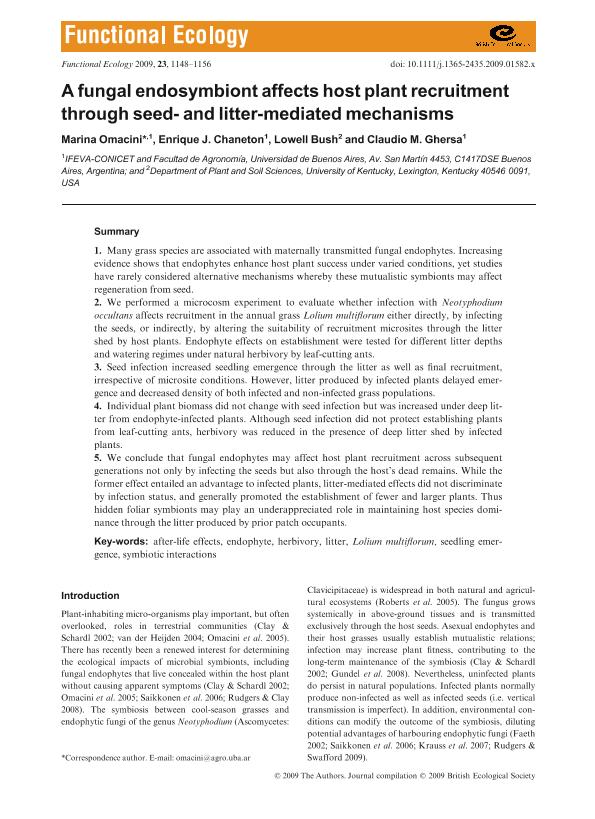Mostrar el registro sencillo del ítem
dc.contributor.author
Omacini, Marina

dc.contributor.author
Chaneton, Enrique Jose

dc.contributor.author
Bush, Lowell
dc.contributor.author
Ghersa, Claudio Marco

dc.date.available
2020-02-14T20:41:11Z
dc.date.issued
2009-12
dc.identifier.citation
Omacini, Marina; Chaneton, Enrique Jose; Bush, Lowell; Ghersa, Claudio Marco; A fungal endosymbiont affects host plant recruitment through seed- and litter-mediated mechanisms; Wiley Blackwell Publishing, Inc; Functional Ecology; 23; 6; 12-2009; 1148-1156
dc.identifier.issn
0269-8463
dc.identifier.uri
http://hdl.handle.net/11336/97674
dc.description.abstract
1.Many grass species are associated with maternally transmitted fungal endophytes. Increasing evidence shows that endophytes enhance host plant success under varied conditions, yet studies have rarely considered alternative mechanisms whereby these mutualistic symbionts may affect regeneration from seed. 2.We performed a microcosm experiment to evaluate whether infection with Neotyphodium occultans affects recruitment in the annual grass Lolium multiflorum either directly, by infecting the seeds, or indirectly, by altering the suitability of recruitment microsites through the litter shed by host plants. Endophyte effects on establishment were tested for different litter depths and watering regimes under natural herbivory by leaf-cutting ants. Seed infection increased seedling emergence through the litter as well as final recruitment, irrespective of microsite conditions. However, litter produced by infected plants delayed emergence and decreased density of both infected and non-infected grass populations. Individual plant biomass did not change with seed infection but was increased under deep litter from endophyte-infected plants. Although seed infection did not protect establishing plants from leaf-cutting ants, herbivory was reduced in the presence of deep litter shed by infected plants. We conclude that fungal endophytes may affect host plant recruitment across subsequent generations not only by infecting the seeds but also through the host's dead remains. While the former effect entailed an advantage to infected plants, litter-mediated effects did not discriminate by infection status, and generally promoted the establishment of fewer and larger plants. Thus hidden foliar symbionts may play an underappreciated role in maintaining host species dominance through the litter produced by prior patch occupants.
dc.format
application/pdf
dc.language.iso
eng
dc.publisher
Wiley Blackwell Publishing, Inc

dc.rights
info:eu-repo/semantics/openAccess
dc.rights.uri
https://creativecommons.org/licenses/by-nc-sa/2.5/ar/
dc.subject
AFTER-LIFE EFFECTS
dc.subject
ENDOPHYTE
dc.subject
HERBIVORY
dc.subject
LITTER
dc.subject
LOLIUM MULTIFLORUM
dc.subject
SEEDLING EMERGENCE
dc.subject
SYMBIOTIC INTERACTIONS
dc.subject.classification
Agronomía, reproducción y protección de plantas

dc.subject.classification
Agricultura, Silvicultura y Pesca

dc.subject.classification
CIENCIAS AGRÍCOLAS

dc.title
A fungal endosymbiont affects host plant recruitment through seed- and litter-mediated mechanisms
dc.type
info:eu-repo/semantics/article
dc.type
info:ar-repo/semantics/artículo
dc.type
info:eu-repo/semantics/publishedVersion
dc.date.updated
2020-02-07T13:44:51Z
dc.journal.volume
23
dc.journal.number
6
dc.journal.pagination
1148-1156
dc.journal.pais
Reino Unido

dc.journal.ciudad
Londres
dc.description.fil
Fil: Omacini, Marina. Consejo Nacional de Investigaciones Científicas y Técnicas. Oficina de Coordinación Administrativa Parque Centenario. Instituto de Investigaciones Fisiológicas y Ecológicas Vinculadas a la Agricultura. Universidad de Buenos Aires. Facultad de Agronomía. Instituto de Investigaciones Fisiológicas y Ecológicas Vinculadas a la Agricultura; Argentina
dc.description.fil
Fil: Chaneton, Enrique Jose. Consejo Nacional de Investigaciones Científicas y Técnicas. Oficina de Coordinación Administrativa Parque Centenario. Instituto de Investigaciones Fisiológicas y Ecológicas Vinculadas a la Agricultura. Universidad de Buenos Aires. Facultad de Agronomía. Instituto de Investigaciones Fisiológicas y Ecológicas Vinculadas a la Agricultura; Argentina
dc.description.fil
Fil: Bush, Lowell. University of Kentucky; Estados Unidos
dc.description.fil
Fil: Ghersa, Claudio Marco. Consejo Nacional de Investigaciones Científicas y Técnicas. Oficina de Coordinación Administrativa Parque Centenario. Instituto de Investigaciones Fisiológicas y Ecológicas Vinculadas a la Agricultura. Universidad de Buenos Aires. Facultad de Agronomía. Instituto de Investigaciones Fisiológicas y Ecológicas Vinculadas a la Agricultura; Argentina
dc.journal.title
Functional Ecology

dc.relation.alternativeid
info:eu-repo/semantics/altIdentifier/doi/http://dx.doi.org/10.1111/j.1365-2435.2009.01582.x
dc.relation.alternativeid
info:eu-repo/semantics/altIdentifier/url/https://besjournals.onlinelibrary.wiley.com/doi/full/10.1111/j.1365-2435.2009.01582.x
Archivos asociados
